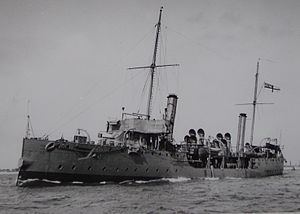Name HMS Dryad Commissioned 21 July 1894 Fate Broken up in 1920 Launched 22 November 1893 Draft 4 m | Laid down 15 April 1893 Renamed HMS Hamadryad in 1918 Construction started 15 April 1893 Length 80 m Tons burthen 970,700 kg | |
 | ||
Class and type | ||
HMS Dryad was the name ship of the Dryad-class torpedo gunboats. She was launched at Chatham Dockyard on 22 November 1893, the first of the class to be completed. She served as a minesweeper during World War I and was broken up in 1920.
Contents
Design
Ordered under the Naval Defence Act of 1889, which established the "Two-Power Standard", the class was contemporary with the first torpedo boat destroyers. With a length overall of 262 ft 6 in (80.01 m), a beam of 30 ft 6 in (9.30 m) and a displacement of 1,070 tons, these torpedo gunboats were not small ships by the standard of the time; they were larger than the majority of World War I destroyers. Dryad was engined by Maudslay, Sons & Field with two sets of vertical triple-expansion steam engines, two locomotive-type boilers, and twin screws. This layout produced 3,500 indicated horsepower (2,600 kW), giving her a speed of 18.2 knots (33.7 km/h). She carried between 100 and 160 tons of coal and was manned by 120 sailors and officers.
Armament
The armament when built comprised two QF 4.7-inch (12 cm) guns, four 6-punder guns and a single 5-barrelled Nordenfelt machine gun. Her primary weapon was five 18-inch (450-mm) torpedo tubes, with two reloads. On conversion to a minesweeper in 1914 two of the five torpedoes were removed.
Mediterranean service
On 14 January 1900 Dryad left Chatham for the Mediterranean in order to relieve Hussar, which returned to Devonport to pay off. Lieutenant Charles Coode was appointed in command on 15 January 1902. From June that year she was lent to the East Indies Squadron for special service in the Gulf of Aden.
Tender to the Navigation School
In 1906 she was chosen as the tender to the Navigation School, conducting navigation training of officers at sea. In due course her name came to be used for the Navigation School itself, and then for HMS Dryad, the shore establishment at Southwick House in Hampshire.
Wartime service as a minesweeper
By 1914 Dryad had been converted to a minesweeper and was operating in the North Sea from the port of Lowestoft.
Gunner Ernest Martin Jehan and three other gunners from Dryad were assigned to the Q-ship Inverlyon, with Jehan in command. On 15 August 1915 they sank the German submarine UB-4 with gunfire. Jehan was awarded the Distinguished Service Cross for his part in the action.
Disposal
She was renamed Hamadryad in 1918 and was sold to H Auten & Co on 24 September 1920 for breaking.
